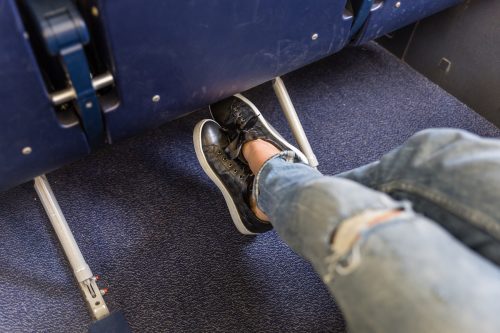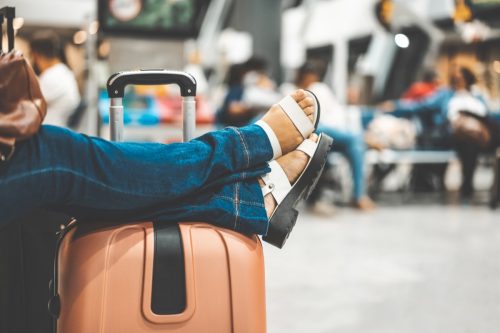6 Shoes to Never Wear on an Airplane, Podiatrists Say

When commercial flights first became available to the public, it was customary for passengers to dress up in suits and fine dresses. Today, you’re far less likely to see travelers sporting their Sunday best as more comfortable styles have taken off in popularity. Experts say that while today’s approach is perhaps less glamorous, the change may be for the best—especially when it comes to footwear. In fact, podiatrists say there are six types of shoes to never wear on a plane in order to put health and safety first. Keep reading to learn more.
RELATED: 10 Clothing Items You Shouldn’t Wear on a Plane.
1
High heels

High heels were once a non-negotiable flying staple for women, but today experts warn against wearing them on an airplane.
“Heels are notorious for having small toe boxes, so feet and toes can easily become cramped when they swell due to decreased circulation,” explains Mauricio Garcia, MD, an orthopedic surgeon and the senior project manager for Hyper Arch Motion. “The pitch of high heels puts pressure on the toes and balls of your feet, which can lead to discomfort while walking to gates and through airport terminals.”
Julie Schottenstein, DPM, a podiatrist at The Schottenstein Center, notes that in addition to being uncomfortable, high heels can also pose a safety hazard in the event of turbulence or an emergency: “They may be difficult to move quickly in.”
To that point, Brett Manders, an international air pilot and author of Behind the Flight Deck Door, points out that in the event of an emergency landing, you may actually be required to take your high heels off because of the risks they pose.
RELATED: 7 Clothing Items to Never Wear Through Airport Security, Experts Say.
2
Tight or pointy-toed shoes

Shoes that are too tight or pointed in the toes can also cause issues in the air, Garcia says.
“Shoes that are tight on your feet or squeeze your toes while on the ground can end up feeling like a vice grip in the air, especially during longer flights when feet tend to swell due to reduced circulation,” he explains. “This constriction won’t give your feet and toes the space they need, which can cause significant discomfort throughout a flight.”
3
New shoes

Wearing new shoes on a flight is another common mistake people make—and one that Garcia says is best avoided.
“It’s a risk to wear new shoes on a plane because you don’t know how or where they will potentially rub on your feet as you move through the airport—especially if you have to hustle to make a connecting flight!” he tells Best Life.
Instead, stick to your old favorites that you know won’t cause any unexpected rubbing or blistering. “The safer, smarter option is to wear familiar shoes that you know will keep you comfortable and safe throughout your travel,” Garcia says.
RELATED: 26 Best Trip-Planning Hacks Straight From Travel Agents.
4
Flip-flops and sandals

Flip-flops may be convenient as you work your way through airport security, but they’re not the best choice for flying.
“Flip-flops lack arch support which can leave feet feeling fatigued after walking through airport terminals. Without any protective upper material, wearing flip-flops on a plane can leave feet cold and uncomfortable for long periods, plus they present a safety hazard should there be an emergency on the plane,” Garcia says.
Schottenstein adds that flip-flops and open-toed sandals can be unhygienic, exposing your feet to potential hazards when you travel—especially if you have to use the restroom. Many experts also agree that wearing flip-flops is, by all practical measures, comparable to going barefoot, which is generally considered poor flight etiquette.
RELATED: 9 Foods That Can Cure Jet Lag, Experts Say.
5
Knee-high boots

Flying can affect your circulation, especially on long-haul trips, so you should take this into consideration as you plan your in-air wardrobe.
“Sitting for long periods of time on a plane can encourage stasis of the blood in our legs, leading to higher potential for things like blood clots,” says Schottenstein, noting that this can quickly become dangerous. “Knee-high boots can lock up the calf muscle even more,” she notes.
Instead, the podiatrist says it is best to choose shoes that won’t limit leg mobility while on an airplane. “It is also advised to move the ankle, knee, and hip while flying to help with circulation along with wearing compression socks to aid in this as well,” she adds.
RELATED: 11 Worst Days and Times to Fly on an Airplane.
6
Shoes that are not breathable

While flip flops may air out your feet a bit too much, Schottenstein says that shoes that aren’t breathable should also be left at home.
“Shoes that are not breathable can cause sweat to accumulate. This can encourage an environment where fungal infections could possibly develop,” she tells Best Life.
Garcia says that when choosing shoes for airplane travel, you should look for those that keep you both comfortable and safe. “Opt for familiar shoes with features like wide toe boxes, adequate arch support, and adjustable closures,” he suggests.
For more travel tips sent directly to your inbox, sign up for our daily newsletter.